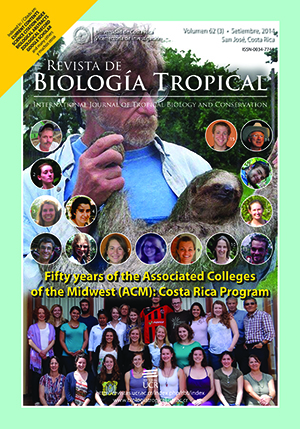Abstract
Studies on reproductive aspects, spore morphology and ultrastructure of Lycopodiaceae are not very common in the scientific literature, and constitute essential information to support taxonomic and systematic relationships among the group. In order to complete existing information, adding new and broader contributions on these topics, a comparative analysis of the sporogenesis ultrastructure, with emphasis on cytological aspects of the sporocyte coat development, tapetum, monoplastidic and polyplastidic meiosis, sporoderm ontogeny and ornamentation of the mature spores, was carried out in 43 taxa of eight genera of the Lycopodiaceae: Austrolycopodium, Diphasium, Diphasiastrum, Huperzia (including Phlegmariurus), Lycopodium, Lycopodiella, Palhinhaea and Pseudolycopodiella growing in the Andes of Colombia and the Neotropics. For this study, the transmission electron microscopy (TEM) samples were collected in Cauca and Valle del Cauca Departments, while most of the spores for scanning electron microscopy (SEM) analysis were obtained from herbarium samples. We followed standard preparation procedures for spore observation by TEM and SEM. Results showed that the sporocyte coat is largely composed by primary wall components; the sporocyte develop much of their metabolic activity in the production of their coat, which is retained until the spores release; protective functions for the diploid cells undergoing meiosis is postulated here for this layer. The abundance of dictyosomes in the sporocyte cytoplasm was related to the formation and development of the sporocyte coat. Besides microtubule activity, the membrane of sporocyte folds, associated with electrodense material, and would early determine the final patterns of spore ornamentation. Monoplastidic condition is common in Lycopodium s.l., whereas polyplastidic condition was observed in species of Huperzia and Lycopodiella s. l.. In monoplastidic species, the tapetum presents abundant multivesicular bodies, while in polyplastidic species, the secretory activity of the tapetum is less intense. Sporoderm development is centripetal, exospore is the first formed layer, then the endospore and, if present, perispore is the final deposited layer. Adult spores of the Lycopodiaceae showed two patterns of ornamentation: negative or caviform (foveolate spores) and positive or muriform ornamentation, the latter with two subtypes (rugate and reticulate spores). The spores of Huperzia are characteristically foveolate, the rugate spores were found in a few species of Huperzia and in all of the Lycopodiella s. l. taxa studied, while Lycopodium s.l. spores bear reticulate ornamentation. Numerous ornamentation traits are diagnostic at the specific level. The types of ornamentation found do not support the recent extreme fragmentation of the family in several genera, but could match, a priori, with the idea of three subfamilies. The findings of sporogenesis, extremely similar in all taxa studied, point more to consider fewer genera, more comprehensive, than the recent, marked splitting of the family.
Comments

This work is licensed under a Creative Commons Attribution 4.0 International License.
Copyright (c) 2014 Revista de Biología Tropical






